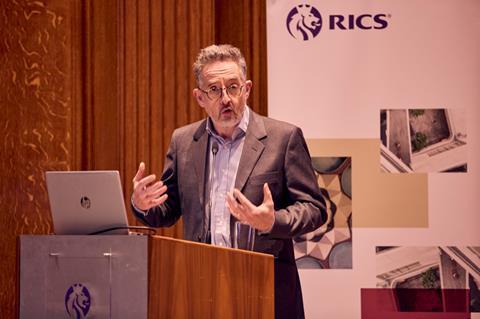The past 12 months have been turbulent politically and economically. Does the year ahead look like an improvement or more of the same? A range of figures from across the industry give their views

‘My biggest hope is that we see a commitment to funding streams that secure a pipeline of work and budgets that allow for investment in high quality design and enable a longer-term view’
Rachel Bell, board director, Stride Treglown
The overriding hope for 2025 is for less turmoil, be it political, economic or social. The government has set out ambitious targets for housebuilding, for more renewal of the schools and hospitals estate and for net zero, but none of these will be achieved without a calmer and more optimistic backdrop.

At Stride Treglown we’re feeling cautiously optimistic and see potential for growth. Alongside our more traditional public sector markets we have secured significant projects in science and technology, retrofit and reuse, all of which we hope will lead to further opportunities.
And we should not ignore exploring opportunities that may lie further ahead. I was at a fascinating discussion recently about the future of data centres in space. It may seem fanciful to some, but we need to pay due attention to these conversations about the longer term.
Who thought AI would be playing such a central role, even 10 years ago? It is vital that we maintain enough capacity to look further ahead; it may not be me or my colleagues who will be working on these projects, but we must make sure there is a healthy industry for the next generation.
More immediately, my biggest hope is that we see a commitment to funding streams that secure a pipeline of work and budgets that allow for investment in high quality design and enable a longer-term view. The trend for personal purchases is to buy well and consume less. We are seeing the rise of preloved and vintage as something that is desirable.
I do see some brightness on the horizon. The Building Safety Act could be a catalyst for a wider transformation of the industry
There is still too much corner cutting within the built environment and, following the demise of ISG, a feeling of inevitability as we await the next high-profile casualty. I suspect smaller businesses may find 2025 challenging and in architecture we are already seeing some shut up shop and others joining larger entities.
With fee levels so low as to be unsustainable, we also need to address collectively the current undercutting and crazy pricing we are seeing, without killing a healthy level of competition.
I do see some brightness on the horizon. The Building Safety Act could be a catalyst for a wider transformation of the industry and a move towards more quality. Conversations around sustainability broaden from net zero carbon and encompass regenerative design and biodiversity, and social value is rising up the agenda as we seek to regenerate areas of towns and cities in a way that genuinely benefits citizens.
>> Also read: Act now and make the new year a time of real change
‘We can expect a substantial increase in public sector infrastructure, including modernising and expanding the nation’s ports, energy and other vital utilities sectors’
Mark Robinson, chief executive, Scape
The UK economy is facing some tough challenges and, like other industries, construction will have to square up to some strong headwinds in the coming months. But, as we spelt out in our Charter for Change, construction is a key driver of economic growth, innovation and community enrichment. Taking a smarter approach to how we procure, deliver and manage built environment assets and infrastructure has the potential to address and mitigate some of the biggest challenges we are likely to face.

The government has promised a far-reaching revitalisation of public services. We can therefore expect a substantial increase in public sector infrastructure, including modernising and expanding the nation’s ports, energy and other vital utilities sectors. This will require substantial investment, designed to improve the nation’s connectivity and support its economic growth. Such efforts will inevitably benefit the construction industry.
Earlier this year we announced the launch of two new utilities consultancy frameworks and the consultants that will deliver up to £1.25bn of investment across the UK, designed to empower utility sector organisations to shape their utilities programmes and projects, whilst supporting the delivery of low-carbon infrastructure and sustainability targets. We want to see more of this. But even when forthcoming, such investment poses another challenge: skills.
In our Charter for Change, we called on the government to prioritise the upskilling of the workforce and recruitment of future generations through a national recruitment campaign and regional apprenticeship programmes. If we want to deliver the green infrastructure the government envisions, this focus will be even more important.
Just last month, the government announced a £100m investment in 32 multi-skills training hubs across the country. These are designed to train apprentices and usher in a new generation of highly skilled workers who can fast-track the urgently needed housebuilding.
It will interesting to see how these initiatives will benefit the industry, our public building projects, and the government’s ambitious growth strategy alike
However, there is still a way to go. Schools, public buildings, roads and of course the green agenda are all critical growth sectors that urgently require an upskilled workforce. This has been clearly outlined by the Construction Leadership Council (of which I was recently appointed co-chair) in a letter issued to Skills England. Illustrating the need for an effective skills system driven by employer demand, the CLC’s letter also demonstrated the ways in which Skills England should help employers benefit from the new levy.
As we move into 2025, it will interesting to see how these initiatives will benefit the industry, our public building projects, and the government’s ambitious growth strategy alike.
It is no secret that a rejig of the planning system would significantly boost output. The construction and real estate industries are hoping the new year ushers in a simplified planning regime, particularly if we are to meet the government’s target to build 1.5 million new homes.
Streamlining the approval process would accelerate project timelines, avoiding costing and delivery issues caused by interest rates that change significantly over a prolonged timeline.
Investment in existing planning departments and the recruitment and training of tomorrow’s planning officers is going to be an important factor in making the process of delivering the built assets – and prosperity – we need a success.
‘My greatest fear is that the dismal status quo will endure. That we won’t grasp the nettle to put in the necessary seismic structural shift’
Jackie Sadek, former government adviser on urban regeneration and presenter of Home Truths, a Building magazine podcast
I do not share the view that the new government has got off to a disappointing start. Despite the headwinds, they have certainly changed the political weather on the house building front. Angela Rayner is talking a good game. And Matt Pennycook is impressing the industry with his intellectual heft, his astonishing energy and capacity for hard work, and his grip of the issues.

In recognition that planned inclusive settlements, with infrastructure delivered up front, is the most cogent response to nimbys, a good tone has been set by the establishment of the New Towns Task Force.
Positive signals are also to be found in the renewed impetus for devolution, giving planning officers more approval powers, the concerted push to bring back proper strategic planning, and some significant call-ins – such as that of the Quinn Estates proposed new settlement at Swale in Kent.
Not to mention the shake-up at Homes England, which has been cautiously well received. Eamonn Boylan instils confidence in the market. More of this please.
But we have to face the fact that we are in a pretty moribund state. And if the spirit seems willing, the flesh is still weak. So, my biggest hope for 2025 would be for a serious structural shift. A transformational change. A recognition that the current model is broken.
Start with the New Towns Task Force being empowered to form a gloves-off delivery unit, with cross-Whitehall buy-in and proper resourcing, in partnership with Homes England. Get the task force to report early. June is miles off. We’ll lose momentum.
Guys, just stop faffing around trying to sort out methodology for choosing sites for new towns. We haven’t manufactured any new land, and we all know pretty much where they will be anyway. Get on with it and name them. Form the necessary development corporations now.
Please stop churning out endless press notices promising this, that and the other, and doubling down on preposterous housing targets that nobody at all believes in
Don’t sacrifice the good to the best. Do give yourselves a bit of wriggle room. To support this, put a serious raft of measures in to support skills training, particularly in FE colleges – tap into the phenomenal entrepreneurial spirit that I always find there. And throw your support behind the emerging consensus for a wholesale return to council housing. This is your moment.
My greatest fear is that the dismal status quo will endure. That we won’t grasp the nettle to put in the necessary seismic structural shift. And that we’ll just limp on with the same tired old eco-system. What my secretary of state, when I was working in government, used to describe as “incrementalist” – and he was such a polite and collegiate man, no more damning indictment could he make!
And please, Mr Government, can you stop talking about housing delivery until you have got something to say. Please stop churning out endless press notices promising this, that and the other, and doubling down on preposterous housing targets that nobody at all believes in. Please stop with the fatuous and flaccid response that planning reform is the answer to absolutely everything.
Please face the challenge of putting in place the long-term support that is needed on skills training, because nobody else can do this. And please don’t leave those local authorities – who are putting their hands up to grow – hanging out there with no encouragement or help. They are hurting.
Delivery delivery delivery – it is all that matters. And not just on housing.
‘The switch from famine to feast is great news for the suppliers involved but will involve a jarring crash of gears as clients and their supply chains race to build capacity across all aspects of delivery’
Simon Rawlinson, partner, Arcadis
If the infrastructure story of the 2020s has so far involved civil engineering on a giant scale – Hinkley Point and HS2, for example – the next five years will see a decisive switch to regulated networks, in both water and power. The UK’s networks are set for a major transformation. In water to meet raised water quality expectations and in power to rewire the grid for a net zero future.

Business plan proposals for RIIO-T3, the transmission programme will total £68bn for a five-year investment period to March 2031. Ofwat also this month approved a combined investment programme worth £104bn for AMP8, doubling the rate of spend. Workload on the UK’s networks has however been a sleeping giant. Spending in the water sector actually fell in the last control period.
The switch from famine to feast is great news for the suppliers involved but will involve a jarring crash of gears as clients and their supply chains race to build capacity across all aspects of delivery – from programme controls through design and engineering, to boots on the ground. Regulated utilities are required to deliver their investment efficiently, and planning for these programmes is well underway, but there is a risk that the UK will once again find itself “over-programmed”, and that’s before the planning system gets fixed.
Their network programmes will be an acid test of how a whole sector including finance, training and skills recruitment can be mobilised fully to deliver on a national mission
NISTA, the new combined national infrastructure planning authority, will face a monumental task to assess and understand the implications of this “wall of work” on the capacity of the industry to deliver other, pro-growth infrastructure. The government wants to “crowd-in” more private investment into the UK, The regulated utilities have been very successful in channelling this capital.
Their network programmes will be an acid test of how a whole sector including finance, training and skills recruitment – not just designers and contractors – can be mobilised fully to deliver on a national mission.
Over and above the transformation in “pipes and wires” that the network programmes will deliver, the parallel challenge of scaling UK infrastructure delivery capacity also needs to be solved.
‘We need to maintain the momentum on climate change mitigation’
Yetunde Abdul, director of industry transformation, UKGBC
In spring 2025, UKGBC will launch the UK climate resilience roadmap for the built environment to drive understanding and consensus around critical climate resilience actions and policies, pushing for their swift adoption. As the urgency around climate resilience grows, the knowledge shared in this roadmap will be ready for immediate implementation. A key focus for 2025 will be finding innovative mechanisms to unlock funding for resilience projects and associated nature-based solutions.

We also need to maintain the momentum on climate change mitigation. Last year saw the launch of the UK Net Zero Carbon Buildings Standard, a collaborative, industry-led initiative to set science-led limits and targets for different kinds of buildings to be defined as net zero, aligned to our carbon and energy budgets.
It also sets out all the requirements and approach to verifying that these have been achieved. This increased clarity will help inform policy and reduce greenwashing around net zero building claims, increasing credibility and rigour. We hope the government’s net zero building strategy, which is due out after the completion of the spending review process, will also drive action in this area.
As well as bringing down energy demand in buildings, UKGBC expects built environment organisations to more actively engage with the electricity system to encourage wider grid decarbonisation. This may be through generating and exporting renewable electricity on site or through procurement.
Addressing supply chain emissions is another area we expect to receive greater attention, as organisations seek to address their scope 3. UKGBC has recently launched a workstream on supply chain decarbonisation to enable cross-sector collaboration on this topic.
We expect organisations to scale up supply chain engagement initiatives to improve data quality and availability and build a better understanding of requirements, and also drive for greater procurement of low carbon materials.
As we develop new sustainable technologies and methodologies, we also need to develop the skills to enable their implementation
The concept of the circular economy has been becoming more widely understood in recent years. UKGBC expects this trend to continue with the development of more established secondary material marketplaces, through brokerage, marketplace and take-back-scheme models. Material passports have continued to gain traction, with various platforms emerging and the European Commission looking at regulation regarding a digital product passport for the construction sector.
Calls are growing louder for the built environment to move beyond a form of sustainability that only minimises negative impacts, towards having an actively positive, regenerative impact on people and planet. This increases the importance of taking a place-based approach to design and development, that fosters and enables community co-design.
UKGBC’s new regenerative places programme is responding to this, exploring how local retrofit strategies can be leveraged to deliver broader regenerative benefits to communities. Coupled with the government’s plan for devolution there will likely be greater emphasis placed on action and engagement at the local level. Innovative technologies are also being developed and deployed to support with this, to enable data to be collected and presented in more engaging ways.
Underpinning all of these areas is the importance of upskilling and education. As we develop new sustainable technologies and methodologies, we also need to develop the skills to enable their implementation. This also applies to existing technologies where a skills gap can often be a key barrier to deployment. Throughout 2025 and beyond we need to ensure this doesn’t continue to be a bottleneck or cause the ineffective use of solutions and therefore distrust.
‘Collaboration, innovation and a commitment to addressing current challenges will be essential in fostering a better built environment’
Festus Moffat, director, John Robertson Architects (JRA)

The full implementation of the Building Safety Act in 2024 has brought about a seismic shift in how we work, reshaping roles and responsibilities across the industry. While the initial adjustment has been challenging, I hope 2025 will mark a turning point – a year when the industry adopts a more mature and collaborative approach to navigating this new regulatory environment.
At the same time, the climate crisis continues to demand urgent action. Modern methods of construction are often lauded as being critical to meeting sustainability goals. However, the adoption of these techniques is being hampered by a lack of robust, proven data to demonstrate compliance with Building Regulations. This data gap must be addressed to unlock the full potential of MMC while ensuring safety and performance.
Alongside this, the “retro-first” movement – prioritising the reuse and refurbishment of existing buildings – has gained significant momentum. I anticipate that in 2025, this approach will become even more prevalent, celebrated not only for its sustainability benefits but also for the unique character it brings to our built environment. Retrofitting offers an opportunity to blend heritage with innovation, creating spaces that are both functional and inspirational.
Appointment decisions should prioritise expertise and capability rather than hinge predominantly on an organisation’s willingness to accept onerous contract term
The challenges of adapting to these new ways of working have been compounded by recent insolvencies of major industry players, most notably ISG. These events underscore the need to redefine how risk and liability are distributed within the sector.
I hope that 2025 will spark meaningful debate on this critical issue. Appointment decisions should prioritise expertise and capability rather than hinge predominantly on an organisation’s willingness to accept onerous contract terms.
The industry stands at a crossroads. Collaboration, innovation and a commitment to addressing current challenges will be essential in fostering a built environment that is safer, more sustainable and more inclusive for the future.”
‘Unless we find cleverer ways of separating the delivery of affordable homes from the delivery of market homes, we will be stuck in the story that the economy writes for us’
Martyn Evans, creative director, U&I
Our new government has had a faltering start but, in the last few weeks, it has been busy making announcements that impact our sector. Changes to the NPPF, a raft of policies to unlock housebuilding and smooth the planning process, and more to come on industrial strategy and public sector infrastructure investment will all shape how we are thinking about our businesses in the new year.
In truth, unless it can wield power through its own investment, the impact that central government can bring to bear on the more acute problems in our sector is limited without everyone agreeing what the answers might be and moving ahead in concert to deliver what we need.

I am not a volume housing expert but, if we just keep talking about the 1.5 million homes target as a glib number without digging more deeply into a discussion about what kind of homes we need most urgently, that focus will slip. The most crucial issue to solve, especially in our towns and cities where land values are highest, is how we provide more affordable homes for families on low incomes, key workers and those who make up the backbone of our economy.
Even with significant Homes England funding, so long as we rely on the private sector housebuilders to provide the means to deliver the affordable and social housing we need, we are entirely at the mercy of the market. In a time of uncertainty, however well-meaning housebuilders might be, they are primarily interested in looking after their shareholders’ money and will only build as many homes as suits them.
Unless we find cleverer ways of separating the delivery of affordable homes from the delivery of market homes, we will be stuck in the story that the economy writes for us. I hope that, as 2025 unfolds, Matthew Pennycook, our very well-thought-of new housing minister with a hugely bright and engaged team, can lead the debate towards some practical answers that will deliver what we need.
We are not a sector known particularly for innovation – so maybe we need to change that
But it isn’t all on him. We have to play our part too. If we are in any way engaged in solving the key housing problem, then we have to understand what it is that we can do to ensure a good solution. And that is to deliver quality.
It is no good meeting any kind of target if all we care about is the numbers. What good will it do if we manage to build 1.5 million low-quality homes?
Of course, it’s not easy. When the economics make life in our sector hard, costs are cut, and quality suffers. But that is where we have to put our best foot forward and work as hard and as tirelessly as we can to not let that happen. It is entirely possible if we are smart.
We are not a sector known particularly for innovation – so maybe we need to change that. And that will only happen if we care enough, work out how to collaborate more effectively, challenge each other, be curious, learn, never settle for “that’ll do” and talk to each other more.
‘I hope that we will start to consider more than just the embodied carbon of the materials we’re using’
Anna Beckett, associate director, Buro Happold
When it comes to sustainability, it often feels like progress is moving at a glacial pace, and that both metaphorically and literally the glacier will have melted by the time we get anywhere. It’s easy to feel disheartened, but in 2024 the construction industry made some huge steps forward, as well as setting the groundwork to continue doing so in 2025.

In particular, the conversation around the reuse of existing buildings changed pace, with the controversy around the proposed M&S demolition bringing the topic to the top of the agenda. Whether or not you agree with the decision, there’s no doubt that we’re now having much more considered conversations about the buildings we already have, and we’re asking better questions about the way we’re treating them.
The introduction of Westminster council’s retrofit-first policy has helped to prioritise building reuse, and while of course it’s not always possible, the discussion about whether a particular building should be retained or demolished has become much more holistic.
We have started to see the skills we’ve learnt from smaller projects implemented at a much larger scale
When it comes to material reuse, we have started to see the skills we’ve learnt from smaller projects implemented at a much larger scale. We’re figuring out the logistics of removing and re-fabricating steel from the sites we’re working on, and whilst there are still challenges to be overcome (especially when it comes to storage), steel reuse is no longer a theoretical idea. Concrete reuse is rather more problematic, but we’re researching and testing ideas that might make this possible.
It certainly seems like the reuse of steelwork is likely to become more mainstream, and there’s a huge amount of momentum in the industry to make this happen. At some point, we might be able to incorporate reused steelwork into the supply chain as easily as “new” steelwork, and maybe by the end of 2025 we’ll be heading towards that. But hopefully, we’ll also start to see the reuse of other materials accelerate and develop some better systems to facilitate this.
I hope that we will start to consider more than just the embodied carbon of the materials we’re using. Embodied carbon has been a great measure to get the whole industry thinking about our impact on the environment, but it’s just one way of measuring the impact of our work. As we move through 2025, perhaps we can start to consider the impact we’re having more holistically, including the biodiversity impacts and water use involved in material extraction – both things we rarely consider at the moment.
‘In the race to decarbonisation, 2025 is going to be a pivotal year’
Gauri Lamb, CEO, FHP Group
My insights don’t come from an economist’s perspective or an analyst’s desk - they’re grounded in what we’re seeing every day as an SME engineering consultancy working at the coal face of the industry. The challenges are real, but so are the opportunities.
With new regulations, client expectations, and the race toward decarbonisation, 2025 is going to shape up to be a pivotal year. Looking ahead, a few trends stand out:

1. Stricter EPC requirements are driving smarter, more sustainable designs
Energy efficiency has become a top priority for landlords as we approach the 2030 deadline, which requires buildings to achieve at least a B EPC rating. It’s estimated that 15% of commercial properties could become unlettable if they don’t meet these requirements. This has sparked a surge in investment and upgrades, as landlords seek to avoid stranded assets in their portfolios.
One of the most significant shifts is the adoption of heat pumps and energy efficient systems, critical for reducing carbon emissions. However, retrofitting and upgrades can be challenging. At times, functional systems are replaced solely to meet EPC targets, which raises concerns about waste and long-term sustainability.
We have to help clients use their existing buildings more efficiently, avoiding the need to rip out and start again
We have to help clients use their existing buildings more efficiently, avoiding the need to rip out and start again. This approach reduces unnecessary waste, keeps costs in check, and minimizes the carbon footprint of projects.
These challenges require us to look beyond short-term compliance, integrating energy efficiency with future-focused designs, helping landlords not only meet today’s standards but also ensure their buildings remain viable in the future.
2. The resurgence of retail parks and industrial units is fuelling energy upgrades
Retail spaces took a hit during the pandemic, but out-of-town retail parks and destination shopping centres are making a comeback. With many of these sites combining retail, leisure, and dining, they present significant opportunities for energy upgrades.
The warehouse and industrial sectors are equally active, driven by lease renewals and EPC requirements. However, these projects often demand creative problem-solving. Many landlords overlook basic building fabric improvements, putting the onus on consultants like us to find innovative ways to meet energy performance targets.
The industrial property market is growing, with a 6% year-on-year increase. Nearly 40% of landlords have flagged energy efficiency as a top priority in the next year.
3. Decarbonisation efforts in public sector projects, such as prison refurbishments, are setting the tone for broader change
Refurbishments are on the rise in healthcare facilities, student accommodations, and public sector buildings. Local councils often have access to decarbonisation funding but lack the expertise to implement these plans effectively. This is where we, as consultants, step in - offering practical solutions to turn ambitious goals into reality.
One standout example is the Ministry of Justice’s prison refurbishment projects, which highlight the growing role of the public sector in sustainability. These projects show that even traditionally overlooked areas are starting to prioritise energy efficiency and decarbonisation.
A growing trend we’ve seen is the conversion of offices into residential use. These projects, which were once sidelined, are firmly back on the agenda for many landlords. They represent a practical way to adapt underperforming assets while addressing housing shortages - a win-win.
Overall, while we’re seeing opportunities emerge, they often come with tighter budgets and shorter timelines. Despite this, there are reasons to be optimistic. As we tackle the 2030 goals, our industry is helping landlords and clients ensure their assets remain viable and aligned with evolving regulations. By embracing innovation and sustainability, we’re not just keeping up with change - we’re driving it.
























No comments yet